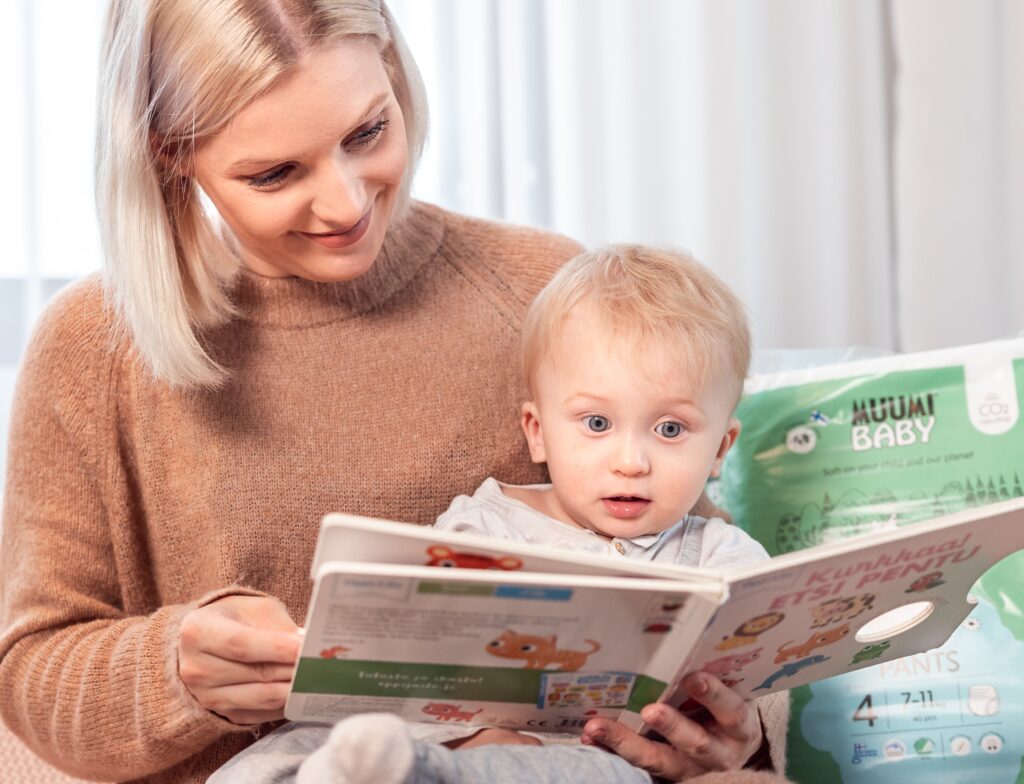Reading together with your baby is much more than just a pleasant pastime. From the earliest months, reading can significantly support your baby’s linguistic, emotional and cognitive development. Even if the child does not yet understand words, reading helps to create a secure and close relationship between the parent and the baby. This article offers practical tips on how to make reading time part of a calming evening routine, as well as recommendations for books suitable for babies. As an added bonus, the Moomin Baby bedtime playlist can complement reading time or even replace it as a calming tool. Discover how shared reading time and calm music can help your baby relax and develop important skills in the early stages of life.
The importance of reading in your baby’s first years
Reading to a baby is one of the most valuable and impactful ways to support a child’s development in the first years of life. Even if your baby doesn’t yet understand all the words or the plot of a story, listening and watching are crucial senses that your baby will pick up immediately. Firstly, reading develops a baby’s listening skills and helps them to pay attention to the rhythm and tone of sounds. This prepares the baby for speech recognition and language learning, which is vital for developing communication skills.
Shared reading sessions strengthen the baby’s emotional bond with the parent. Listening to familiar sounds and feeling the presence of a parent makes the baby feel safe and loved. This emotional connection is the basis for a healthy emotional life and for building trust later in life.
Reading also stimulates your baby’s cognitive development. A variety of sounds, words, pictures and colours help develop your baby’s brain and expand their understanding of the world around them. Clear, contrasting pictures and simple stories are particularly useful in keeping the baby interested and supporting visual development.
All in all, reading to your baby builds a foundation for lifelong learning and love of books. When started early, reading time not only supports language and cognitive development, but also creates a priceless moment of intimacy that will be remembered for a long time.
Explore the stages of your baby’s development during the first year here!
Supporting your baby’s linguistic development
Your baby’s linguistic development starts at an early age, and reading together is a great way to support this development. Even if your baby doesn’t yet understand the meaning of words, listening is important for learning your own language early on. Reading exposes your baby to a wide range of sounds, words and sentence structures that form the basis for future language use.
When a baby is read to, they learn to distinguish between different sounds and notes, which is critical for speech development. Repeated sets of words and phrases gradually help the baby to recognise and remember the meaning of a word. As babies hear their parents’ voices, they also learn to notice the pitches and intonations associated with speech and emotions. This helps children to better understand the connection between emotions and words.
Reading to your baby can also improve their early vocabulary. Every new word that is heard is put into a ‘store’, waiting for the time when the child starts to use them themselves. An active and varied vocabulary is a useful tool later in life, when the child begins to communicate and understand more complex concepts.
Interactive reading is particularly useful. Asking questions, drawing the baby’s attention to the pictures on the page and engaging in the plot of the story help to stimulate the child’s interest in language. In this way, reading is not just a passive activity, but an active and participatory learning experience that contributes significantly to the baby’s linguistic development.
The reading session provides a unique opportunity to focus solely on the baby, strengthening the bond between the parent and child.
Emotional connection: Strengthening the relationship between the parent and the baby
Shared reading time with your baby is not only important for language and cognitive development, but also strengthens the emotional bond between the parent and the baby. When listening to a story read by a parent, the baby experiences the closeness, security and warmth that comes from physical contact and soothing vocalisation.
The reading session provides a unique opportunity to focus solely on the baby, strengthening the bond between the parent and child. This intimate connection helps to build trust and a sense of security, which is important for the baby’s later emotional life. When a baby feels safe and loved, they also learn to better regulate their emotions and behaviour.
The emotional connection is also strengthened by the interaction that takes place during the reading session. Eye contact, smiles, laughs and speech tones communicate love and care to the baby. This emotional interaction helps your baby to develop social skills and understand how to express emotions.
In addition, soothing and repetitive reading moments can become part of a baby’s evening routine, creating predictability and stability in the child’s daily life. Babies benefit from routines as they increase their sense of security and help them to better understand the world around them. Overall, reading provides a valuable opportunity for babies to deepen the emotional connection that is essential for healthy and balanced development.
Promoting cognitive development through reading
For babies, reading is an effective way to stimulate cognitive development at an early stage. Babies are constantly learning about their environment, and reading provides them with a wealth of visual, auditory and linguistic stimuli that feed their brains. Looking and listening as they are being read to helps develop their memory, attention span and problem-solving skills.
By looking at clear pictures and simple stories in books, babies begin to recognise and distinguish shapes, colours and objects. This visual stimulation contributes to the development of visual perception, which is important for later learning of more complex cognitive tasks such as writing and reading.
Hearing sounds and words that your baby might not otherwise hear in everyday life enriches their linguistic environment. This exposure to new sounds and word structures reinforces language processing and vocabulary growth. Babies’ brains are constantly choosing which sounds and words to memorise, and this cognitive exercise lays the foundation for later learning.
The rhythm and repetition of stories also support cognitive development. Repeatedly reading the same book helps strengthen the neurological connections between memory and learning. This repetition creates predictability, which is important for babies because it helps them understand the order and logic of the world.
In summary, reading contributes to a baby’s cognitive development in many ways, making reading not only fun and soothing, but also a valuable learning experience that will bear fruit long into the future.
Tips for creating soothing and meaningful reading sessions
Reading time with your baby can be one of the highlights of the day, but turning it into a calming and meaningful routine can take some planning. Here are some tips to help make reading time together especially rewarding for both the baby and the parent.
- Choose the right time and place: Choose a quiet time and place with few distractions for reading time. Many parents find that the evening before bedtime is best because it helps to calm the baby.
- Create a comfortable atmosphere: Make sure the environment is comfortable and safe. Use soft lighting and settle into a comfortable position with your baby. A soft blanket or chair makes reading time more relaxing.
- Choose age-appropriate books: Choose books with clear, contrasting pictures and simple stories. Babies love to look at bright colours and clear shapes that keep their interest. Interactive elements such as touchable, audible or moving parts can also enrich reading time.
- Be interactive: Use different voices and intonations when reading and draw baby’s attention to the pictures in the book by pointing to them. You can ask simple questions even if your baby is not yet responding: Interaction sets the stage for future engagement.
- Repeat stories the baby enjoys: If you notice that your baby particularly enjoys a particular book or story, don’t hesitate to read it again and again. Repetition helps reinforce learning and brings a sense of security.
Reading sessions can be one of the best ways to spend quality time with your baby. Not only do they promote language, cognitive and emotional development, but they also build beautiful memories that will last a lifetime.
Discover the daily routine of a newborn baby here!

Best books for babies: Clear pictures and interactive elements
When choosing books for your baby, it is important to pay attention to the content and pictures. To capture babies’ attention and support their development, choose books with clear, contrasting pictures and simple stories. Such books help to stimulate the baby’s visual senses and keep their interest.
Clear and bright pictures are particularly important because babies’ vision develops in phases. High contrast pictures, such as black and white or brightly coloured objects on a simple background, are easier for babies to perceive. In addition, pictures that show familiar objects and faces help babies to recognise and learn about objects and things around them.
Interactive elements such as embossed pages, flaps, mirrors or sound-producing parts add value and make reading moments more fun and educational. Books with different textures, for example, help develop babies’ sense of touch and motor skills by allowing them to experiment and explore the pages themselves.
Classic picture books, where simple stories lead your baby into a fairytale world, are also a great choice. Stories do not need to be complex; often simple narratives with a clear beginning and end are sufficient. Books with lyrics and rhyming texts help to capture the baby’s attention and support language development through sounds and rhythms.
Recommended books for babies include “Goodnight Moon” by Margaret Wise, “The Very Hungry Caterpillar” by Eric Carlie and “Peek-a-Baby” by Karen Katz. These books have clear illustrations and interactive elements that make them meaningful and developmentally appropriate reading options for little ones. Overall, well-chosen books can enrich a baby’s reading time and provide a variety of stimuli to support their overall development.
The importance of bedtime routines: Turning reading sessions into soothing and repetitive routines
Bedtime routines are important for babies because they provide predictability and a sense of security, which together help your child to calm down and prepare for bedtime. One of the most effective ways to create calming and repetitive routines is to include reading time in your baby’s evening routine.
Adding reading to the evening routine can serve as a signal to your baby that bedtime is approaching. Not only will this help ease the transition from an active day to a peaceful night’s sleep, it will also help create pleasant and safe memories that can last a lifetime.
Reading time before bedtime provides an opportunity to slow down and focus on being together. Soft sounds and calm stories will soothe your baby and help them relax. This can be particularly helpful for babies who have difficulty settling down in the evening. Reading also reduces exposure to blue light, which can disrupt a baby’s sleep rhythm, unlike watching TV or using smart devices, for example.
When reading sessions are repeated every night, they become a familiar and predictable part of your baby’s evening routine. This repetition helps your baby understand how the day goes and increases their sense of security. It can also help parents establish a structured and consistent bedtime routine, which can reduce sleep-related challenges.
Ultimately, soothing and repetitive reading sessions not only help the baby fall asleep, but also strengthen the bond between parent and child. Spending quiet moments together with a book sets the stage for a lifetime of learning and a love of books.
Check out our tips for building a safe and cosy room for your baby here!
Moomin Baby bedtime playlist: The role of music in calming your baby
Music has an incredible power to soothe and relax, making it a great addition to your baby’s evening routine. The Finnish Moomin Baby bedtime playlist is specially designed to help soothe babies and support them at bedtime. The soft, calm melodies create a soothing environment that prepares baby for sleep.
The calming music helps to reduce baby’s stress levels and create a sense of security. Soft melodies and slow tempos mimic the heartbeat, which can be particularly soothing for the baby, reminding them of the safe environment of the mother’s womb. This can help your baby relax and fall asleep more quickly.
The Finnish Moomin Baby bedtime playlist is full of gentle tunes, perfect for background music for bedtime routines or reading time. You can play the playlist quietly in the background while reading to your baby, creating a peaceful and harmonious atmosphere. This combination of a gentle flow of words and music can make reading time even more soothing and enjoyable.
Music can also help you establish a bedtime routine. When the same bedtime playlist is played every night, your baby will begin to associate music with being close to bedtime. This can make the transition to sleep easier and smoother, allowing both baby and parents to enjoy a more restful night’s sleep.
In summary, the Finnish Moomin Baby bedtime playlist provides the perfect complementary element to baby’s evening routine, helping your baby to relax and prepare for a peaceful night’s sleep. You can find the Finnish Moomin Baby bedtime playlist here.
This helps to create a comfortable and safe environment where the baby feels loved and secure.
Reading sessions and music: The unifying force at baby’s bedtime
By combining reading sessions with calm music, you can create the perfect soothing routine for your baby. This combination harnesses the power of both linguistic stimuli and auditory melodies, making bedtime a particularly harmonious and sweet time.
During reading time, your baby will hear the soothing sounds of the parent and see inspiring pictures, which will help with cognitive and linguistic development. Adding soft and soothing music, such as the chords of the Moomin Baby bedtime playlist, to the background creates a total calming experience that helps baby relax and prepare for sleep.
Music is an excellent background for reading time, as its soft melodies and slow rhythms can also serve as a source of internal stimuli to help calm the child. Soothing music can reduce external distractions and distracting stimuli, allowing the baby to focus on the parent’s voice and the story. This helps to create a comfortable and safe environment where the baby feels loved and secure.
Combined, reading time and calm music can form a functional routine that signals to the baby that bedtime is approaching. This consistent routine facilitates the transition from activity to sleep, which can reduce the challenges of the evening and help create more pleasant bedtimes. In this way, reading moments combined with music not only make bedtime easier and more enjoyable, but also support the baby’s overall development and strengthen the unified family relationship.
Check out our tips for improving your baby’s sleep here!
Practical tips: How to make reading to your baby a daily routine
Turning reading into a daily routine takes some planning and consistency, but it’s worth the effort. Here are some practical tips to help make reading time a consistent part of your baby’s daily routine.
- Start early: The sooner you start reading to your baby, the sooner they will get used to it. Even a newborn baby will benefit from hearing a parent’s voice and looking at the pictures in a book.
- Choose interesting books: Choose age-appropriate books with clear pictures and contrasts and simple stories. Babies especially like books with bright colours and interactive elements.
- Create a pleasant environment: Make sure that reading time is a comfortable and calming experience. Choose a quiet and comfortable place, such as a rocking chair or bed, and use soft lighting to create a calm atmosphere.
- Make reading part of your evening routine: Incorporate reading into your evening routine to make it a predictable and soothing part of your day. Read to your baby at the same time every night, for example after a bath or just before bedtime.
- Be consistent: Consistency is the key to success. Stick to reading times, even if at first your baby seems uninterested. Gradually, the routine becomes a familiar and expected part of the day.
- Use interaction: Talk and show pictures to the baby. Make sound effects, ask questions and let the baby touch and explore the book – this will increase interest and actively engage the child.
- Encourage and praise: Let your baby participate in the reading session in their own way and encourage them. Praise and smiling faces help to create positive associations with reading.
- Be patient: Not all babies get excited about reading straight away. Be patient and allow time for change – eventually, the regularity and calmness of reading will make reading times enjoyable and anticipated.










